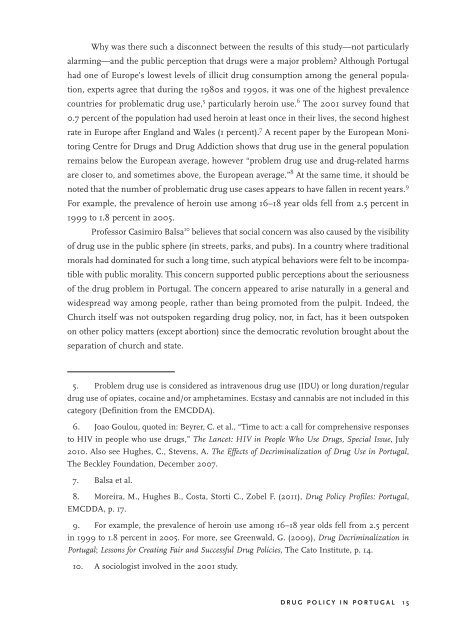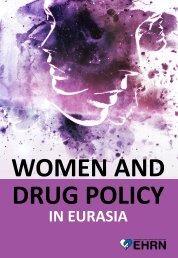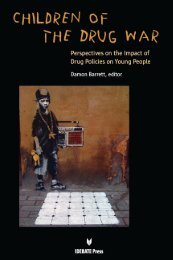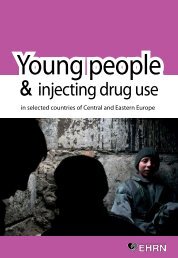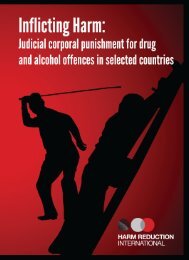From the Mountaintops-2011-Portugal-proof3.indd - Global Initiative ...
From the Mountaintops-2011-Portugal-proof3.indd - Global Initiative ...
From the Mountaintops-2011-Portugal-proof3.indd - Global Initiative ...
You also want an ePaper? Increase the reach of your titles
YUMPU automatically turns print PDFs into web optimized ePapers that Google loves.
Why was <strong>the</strong>re such a disconnect between <strong>the</strong> results of this study—not particularlyalarming—and <strong>the</strong> public perception that drugs were a major problem? Although <strong>Portugal</strong>had one of Europe’s lowest levels of illicit drug consumption among <strong>the</strong> general population,experts agree that during <strong>the</strong> 1980s and 1990s, it was one of <strong>the</strong> highest prevalencecountries for problematic drug use, 5 particularly heroin use. 6 The 2001 survey found that0.7 percent of <strong>the</strong> population had used heroin at least once in <strong>the</strong>ir lives, <strong>the</strong> second highestrate in Europe after England and Wales (1 percent). 7 A recent paper by <strong>the</strong> European MonitoringCentre for Drugs and Drug Addiction shows that drug use in <strong>the</strong> general populationremains below <strong>the</strong> European average, however “problem drug use and drug-related harmsare closer to, and sometimes above, <strong>the</strong> European average.” 8 At <strong>the</strong> same time, it should benoted that <strong>the</strong> number of problematic drug use cases appears to have fallen in recent years. 9For example, <strong>the</strong> prevalence of heroin use among 16–18 year olds fell from 2.5 percent in1999 to 1.8 percent in 2005.Professor Casimiro Balsa 10 believes that social concern was also caused by <strong>the</strong> visibilityof drug use in <strong>the</strong> public sphere (in streets, parks, and pubs). In a country where traditionalmorals had dominated for such a long time, such atypical behaviors were felt to be incompatiblewith public morality. This concern supported public perceptions about <strong>the</strong> seriousnessof <strong>the</strong> drug problem in <strong>Portugal</strong>. The concern appeared to arise naturally in a general andwidespread way among people, ra<strong>the</strong>r than being promoted from <strong>the</strong> pulpit. Indeed, <strong>the</strong>Church itself was not outspoken regarding drug policy, nor, in fact, has it been outspokenon o<strong>the</strong>r policy matters (except abortion) since <strong>the</strong> democratic revolution brought about <strong>the</strong>separation of church and state.5. Problem drug use is considered as intravenous drug use (IDU) or long duration/regulardrug use of opiates, cocaine and/or amphetamines. Ecstasy and cannabis are not included in thiscategory (Definition from <strong>the</strong> EMCDDA).6. Joao Goulou, quoted in: Beyrer, C. et al., “Time to act: a call for comprehensive responsesto HIV in people who use drugs,” The Lancet: HIV in People Who Use Drugs, Special Issue, July2010. Also see Hughes, C., Stevens, A. The Effects of Decriminalization of Drug Use in <strong>Portugal</strong>,The Beckley Foundation, December 2007.7. Balsa et al.8. Moreira, M., Hughes B., Costa, Storti C., Zobel F. (<strong>2011</strong>), Drug Policy Profiles: <strong>Portugal</strong>,EMCDDA, p. 17.9. For example, <strong>the</strong> prevalence of heroin use among 16–18 year olds fell from 2.5 percentin 1999 to 1.8 percent in 2005. For more, see Greenwald, G. (2009), Drug Decriminalization in<strong>Portugal</strong>; Lessons for Creating Fair and Successful Drug Policies, The Cato Institute, p. 14.10. A sociologist involved in <strong>the</strong> 2001 study.DRUG POLICY IN PORTUGAL 15


